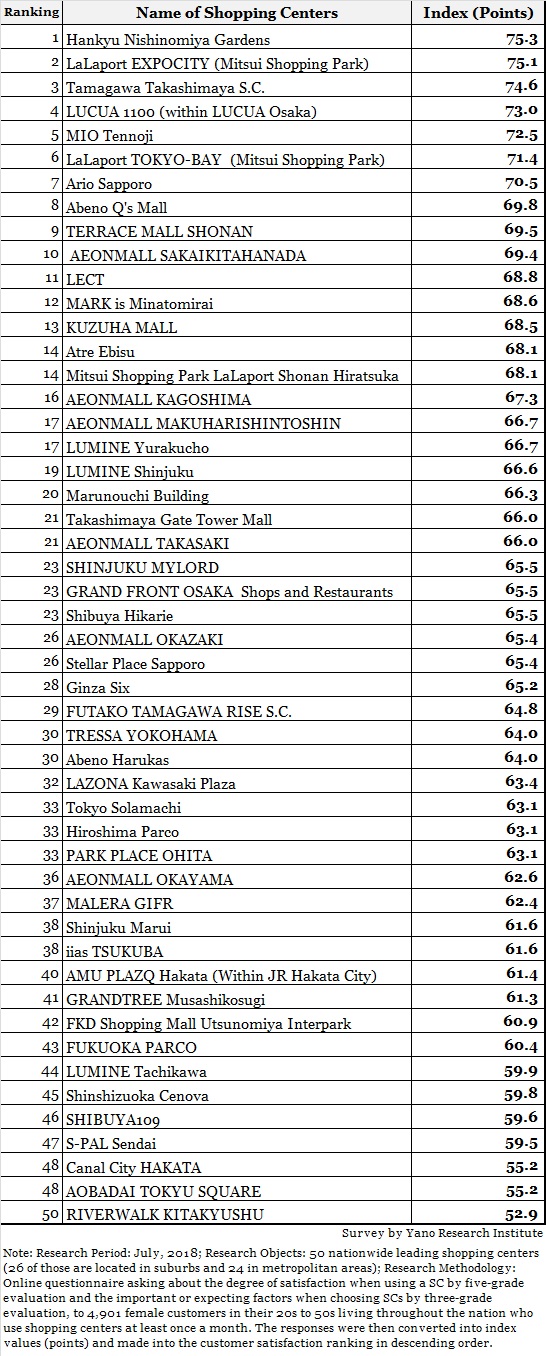No.2020
Shopping Center Customer Satisfaction Ranking in Japan 2018
Shopping Center Customer Satisfaction Ranking in Japan 2018
Yano Research Institute (the President, Takashi Mizukoshi) has conducted a survey on the nationwide leading shopping centers and has found out the trends, strategy, and future outlook of shopping center developers and operators. This report covers the results of consumer satisfaction survey.

Summary of Research Findings
A survey of customer satisfaction ranking of the leading 50 shopping centers (26 of those are located in suburbs and 24 in metropolitan areas) selected based on the sales, size of square measures, and popularity has been conducted by means of online questionnaire asking about the degree of satisfaction when using a SC (hereinafter referred to as “SC”) by five-grade evaluation and the important or expecting factors when choosing SCs by three-grade evaluation, to 4,901 female customers in their 20s to 50s living throughout the nation who use shopping centers at least once a month. The responses were then converted into index values (points) and made into the customer satisfaction ranking in descending order.
According to the survey results, the most satisfying SC was Hankyu Nishinomiya Gardens, which attained the top position also in the last survey. The second place was occupied by LaLaport EXPOCITY (Mitsui Shopping Park), followed by Tamagawa Takashimaya S.C. at the third. LUCUA 1100 and MIO Tennoji came at the fourth and fifth places, respectively.
Noteworthy Topics
The high-ranking SCs have characteristics of having vast spaces and good locations. When analyzing the similar surveys in the past, preferred shopping centers had been located at convenient places close to the stations for the users to easily access by using public transportations and had vast areas with average 50,000 square meters enabling to house about 280 stores.
Hankyu Nishinomiya Gardens is one of the largest SCs in western Japan, with its space 46,000 square meters housing 256 stores (as of FY2017) located in the convenient place, most satisfying users’ expectations.
Research Outline
2.Research Object: 4901 women living throughout the nation in their 20s to 50s
3.Research Methogology: Online Questionnaire
What is Shopping Center Customer Satisfaction Survey?
A survey of customer satisfaction ranking of the leading 50 SC (26 located in suburbs and 24 in metropolitan areas) selected based on the sales, size of square measures, and popularity has been conducted by means of a questionnaire asking about the degree of satisfaction when using a SC by five-grade evaluation and the important or expecting factors when choosing SCs by three-grade evaluation, to 4,901 female customers in their 20s to 50s living throughout the nation who use shopping centers at least once a month. The responses were then converted into index values (points) for showing the satisfaction level, which were analyzed and compared to find out the location, characteristics, and development strategies of high-ranked SCs.
What are Shopping Centers?
Shopping centers, according to Japan Council of Shopping Centers (JCSC), are planned and developed by developers, and should observe the following requirements:
1.The retail space covered by retail businesses should not be less than 1,500sq m.
2.Shopping centers tenants should include, apart from anchor tenants, at least 10 tenants.
3.As for anchor tenants, their area should not exceed 80% of the shopping center area.
However, this restriction does not apply if the retail space of the retail businesses among the other tenants occupies 1,500 square meters or more.
4.An association such as a Tenant Board (Store Association) or the like should be in place in order to conduct activities of common interest such as advertising and jointly held special events.
Published Report
Contact Us
The copyright and all other rights pertaining to this report belong to Yano Research Institute.
Please contact our PR team when quoting the report contents for the purpose other than media coverage.
Depending on the purpose of using our report, we may ask you to present your sentences for confirmation beforehand.